FIN203 Corporate Finance Assignment: Apple Inc. Analysis, Assessment 2
VerifiedAdded on 2023/03/17
|5
|1851
|42
Homework Assignment
AI Summary
This assignment analyzes Apple Inc.'s financial performance from a corporate finance perspective. Part 1 examines Apple's cash conversion cycle, comparing it to Samsung's, and identifies market, technological, and supply chain risks. It also assesses Apple's stock performance relative to market indices and evaluates the company's debt levels and bond pricing. Part 2 focuses on a hypothetical project, using Net Present Value (NPV) and Internal Rate of Return (IRR) analysis to determine whether Apple should build a new store, considering relevant costs, free cash flows, and the project's feasibility, ultimately recommending the project's acceptance based on positive financial metrics and a higher IRR than the cost of capital. The solution includes detailed calculations and appendices supporting the financial analysis and decision-making process.
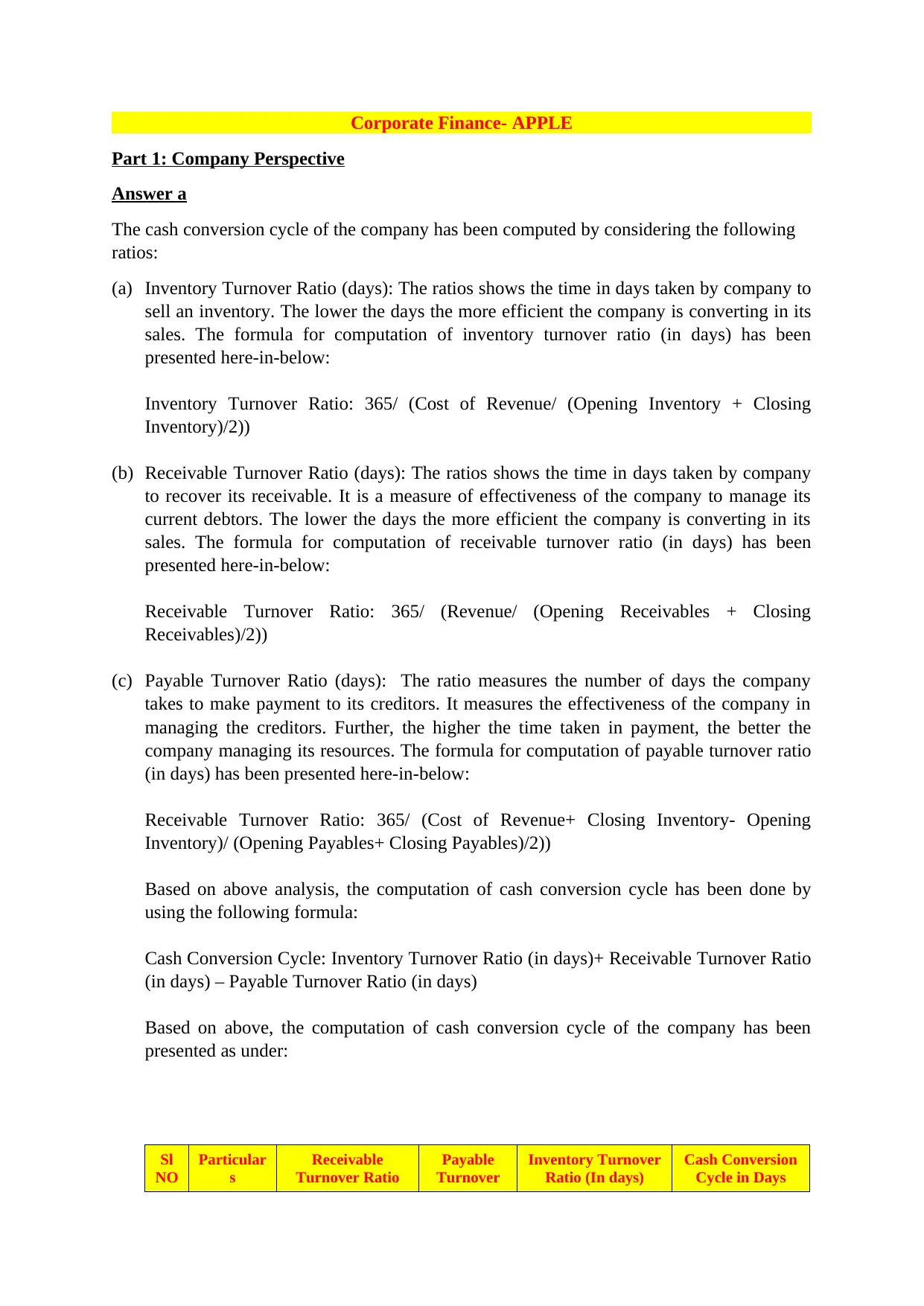
Corporate Finance- APPLE
Part 1: Company Perspective
Answer a
The cash conversion cycle of the company has been computed by considering the following
ratios:
(a) Inventory Turnover Ratio (days): The ratios shows the time in days taken by company to
sell an inventory. The lower the days the more efficient the company is converting in its
sales. The formula for computation of inventory turnover ratio (in days) has been
presented here-in-below:
Inventory Turnover Ratio: 365/ (Cost of Revenue/ (Opening Inventory + Closing
Inventory)/2))
(b) Receivable Turnover Ratio (days): The ratios shows the time in days taken by company
to recover its receivable. It is a measure of effectiveness of the company to manage its
current debtors. The lower the days the more efficient the company is converting in its
sales. The formula for computation of receivable turnover ratio (in days) has been
presented here-in-below:
Receivable Turnover Ratio: 365/ (Revenue/ (Opening Receivables + Closing
Receivables)/2))
(c) Payable Turnover Ratio (days): The ratio measures the number of days the company
takes to make payment to its creditors. It measures the effectiveness of the company in
managing the creditors. Further, the higher the time taken in payment, the better the
company managing its resources. The formula for computation of payable turnover ratio
(in days) has been presented here-in-below:
Receivable Turnover Ratio: 365/ (Cost of Revenue+ Closing Inventory- Opening
Inventory)/ (Opening Payables+ Closing Payables)/2))
Based on above analysis, the computation of cash conversion cycle has been done by
using the following formula:
Cash Conversion Cycle: Inventory Turnover Ratio (in days)+ Receivable Turnover Ratio
(in days) – Payable Turnover Ratio (in days)
Based on above, the computation of cash conversion cycle of the company has been
presented as under:
Sl
NO
Particular
s
Receivable
Turnover Ratio
Payable
Turnover
Inventory Turnover
Ratio (In days)
Cash Conversion
Cycle in Days
Part 1: Company Perspective
Answer a
The cash conversion cycle of the company has been computed by considering the following
ratios:
(a) Inventory Turnover Ratio (days): The ratios shows the time in days taken by company to
sell an inventory. The lower the days the more efficient the company is converting in its
sales. The formula for computation of inventory turnover ratio (in days) has been
presented here-in-below:
Inventory Turnover Ratio: 365/ (Cost of Revenue/ (Opening Inventory + Closing
Inventory)/2))
(b) Receivable Turnover Ratio (days): The ratios shows the time in days taken by company
to recover its receivable. It is a measure of effectiveness of the company to manage its
current debtors. The lower the days the more efficient the company is converting in its
sales. The formula for computation of receivable turnover ratio (in days) has been
presented here-in-below:
Receivable Turnover Ratio: 365/ (Revenue/ (Opening Receivables + Closing
Receivables)/2))
(c) Payable Turnover Ratio (days): The ratio measures the number of days the company
takes to make payment to its creditors. It measures the effectiveness of the company in
managing the creditors. Further, the higher the time taken in payment, the better the
company managing its resources. The formula for computation of payable turnover ratio
(in days) has been presented here-in-below:
Receivable Turnover Ratio: 365/ (Cost of Revenue+ Closing Inventory- Opening
Inventory)/ (Opening Payables+ Closing Payables)/2))
Based on above analysis, the computation of cash conversion cycle has been done by
using the following formula:
Cash Conversion Cycle: Inventory Turnover Ratio (in days)+ Receivable Turnover Ratio
(in days) – Payable Turnover Ratio (in days)
Based on above, the computation of cash conversion cycle of the company has been
presented as under:
Sl
NO
Particular
s
Receivable
Turnover Ratio
Payable
Turnover
Inventory Turnover
Ratio (In days)
Cash Conversion
Cycle in Days
Paraphrase This Document
Need a fresh take? Get an instant paraphrase of this document with our AI Paraphraser
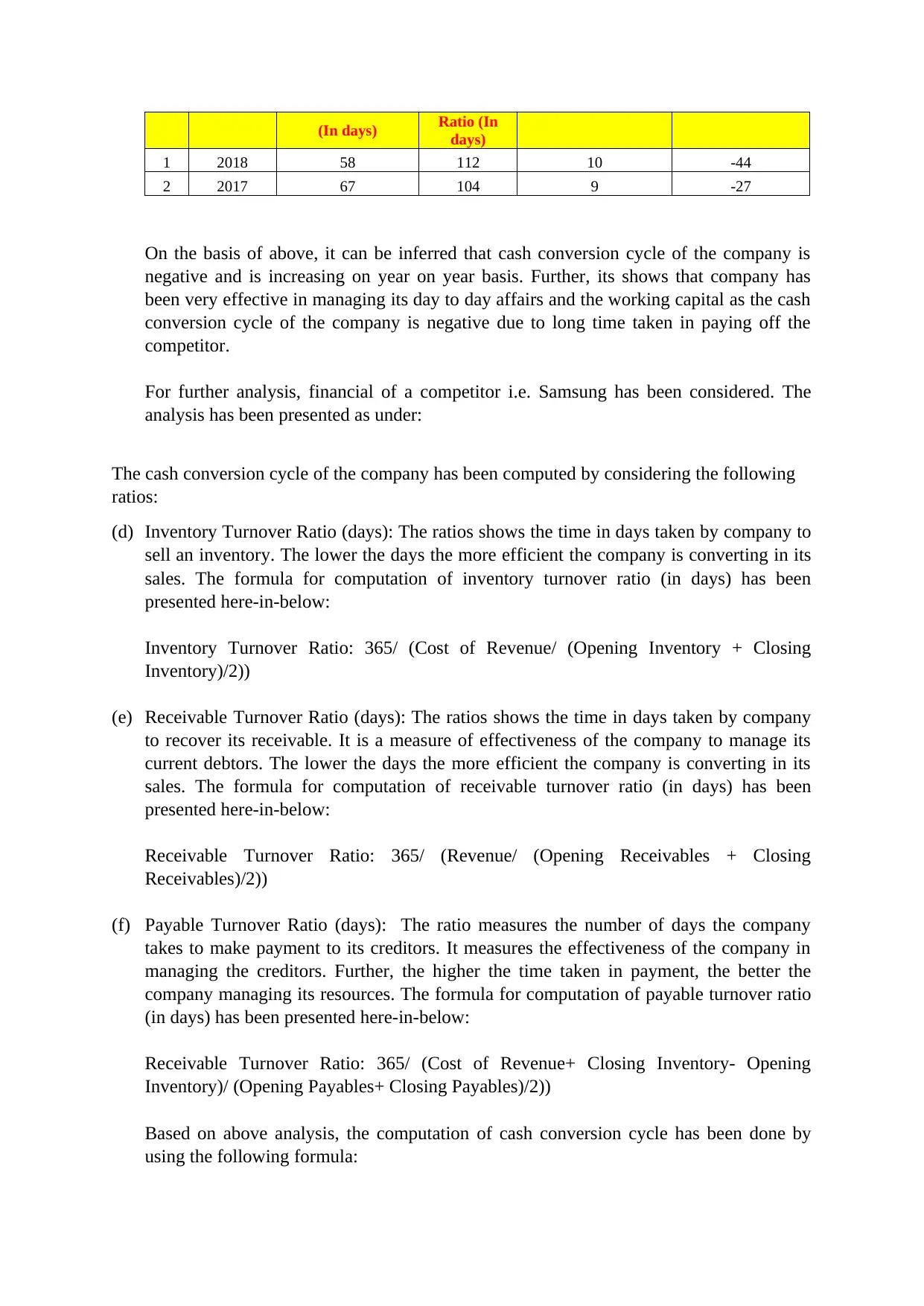
(In days) Ratio (In
days)
1 2018 58 112 10 -44
2 2017 67 104 9 -27
On the basis of above, it can be inferred that cash conversion cycle of the company is
negative and is increasing on year on year basis. Further, its shows that company has
been very effective in managing its day to day affairs and the working capital as the cash
conversion cycle of the company is negative due to long time taken in paying off the
competitor.
For further analysis, financial of a competitor i.e. Samsung has been considered. The
analysis has been presented as under:
The cash conversion cycle of the company has been computed by considering the following
ratios:
(d) Inventory Turnover Ratio (days): The ratios shows the time in days taken by company to
sell an inventory. The lower the days the more efficient the company is converting in its
sales. The formula for computation of inventory turnover ratio (in days) has been
presented here-in-below:
Inventory Turnover Ratio: 365/ (Cost of Revenue/ (Opening Inventory + Closing
Inventory)/2))
(e) Receivable Turnover Ratio (days): The ratios shows the time in days taken by company
to recover its receivable. It is a measure of effectiveness of the company to manage its
current debtors. The lower the days the more efficient the company is converting in its
sales. The formula for computation of receivable turnover ratio (in days) has been
presented here-in-below:
Receivable Turnover Ratio: 365/ (Revenue/ (Opening Receivables + Closing
Receivables)/2))
(f) Payable Turnover Ratio (days): The ratio measures the number of days the company
takes to make payment to its creditors. It measures the effectiveness of the company in
managing the creditors. Further, the higher the time taken in payment, the better the
company managing its resources. The formula for computation of payable turnover ratio
(in days) has been presented here-in-below:
Receivable Turnover Ratio: 365/ (Cost of Revenue+ Closing Inventory- Opening
Inventory)/ (Opening Payables+ Closing Payables)/2))
Based on above analysis, the computation of cash conversion cycle has been done by
using the following formula:
days)
1 2018 58 112 10 -44
2 2017 67 104 9 -27
On the basis of above, it can be inferred that cash conversion cycle of the company is
negative and is increasing on year on year basis. Further, its shows that company has
been very effective in managing its day to day affairs and the working capital as the cash
conversion cycle of the company is negative due to long time taken in paying off the
competitor.
For further analysis, financial of a competitor i.e. Samsung has been considered. The
analysis has been presented as under:
The cash conversion cycle of the company has been computed by considering the following
ratios:
(d) Inventory Turnover Ratio (days): The ratios shows the time in days taken by company to
sell an inventory. The lower the days the more efficient the company is converting in its
sales. The formula for computation of inventory turnover ratio (in days) has been
presented here-in-below:
Inventory Turnover Ratio: 365/ (Cost of Revenue/ (Opening Inventory + Closing
Inventory)/2))
(e) Receivable Turnover Ratio (days): The ratios shows the time in days taken by company
to recover its receivable. It is a measure of effectiveness of the company to manage its
current debtors. The lower the days the more efficient the company is converting in its
sales. The formula for computation of receivable turnover ratio (in days) has been
presented here-in-below:
Receivable Turnover Ratio: 365/ (Revenue/ (Opening Receivables + Closing
Receivables)/2))
(f) Payable Turnover Ratio (days): The ratio measures the number of days the company
takes to make payment to its creditors. It measures the effectiveness of the company in
managing the creditors. Further, the higher the time taken in payment, the better the
company managing its resources. The formula for computation of payable turnover ratio
(in days) has been presented here-in-below:
Receivable Turnover Ratio: 365/ (Cost of Revenue+ Closing Inventory- Opening
Inventory)/ (Opening Payables+ Closing Payables)/2))
Based on above analysis, the computation of cash conversion cycle has been done by
using the following formula:
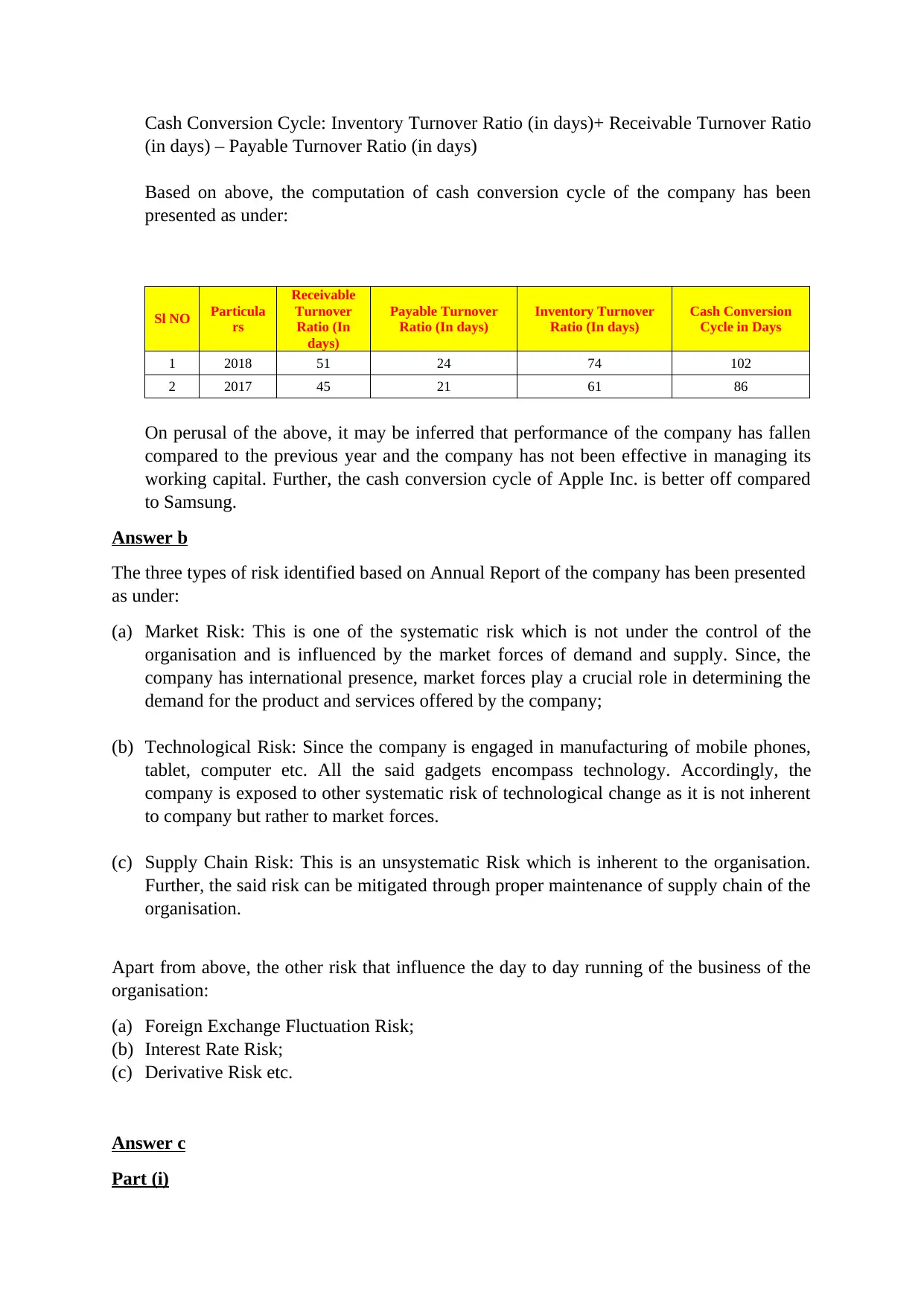
Cash Conversion Cycle: Inventory Turnover Ratio (in days)+ Receivable Turnover Ratio
(in days) – Payable Turnover Ratio (in days)
Based on above, the computation of cash conversion cycle of the company has been
presented as under:
Sl NO Particula
rs
Receivable
Turnover
Ratio (In
days)
Payable Turnover
Ratio (In days)
Inventory Turnover
Ratio (In days)
Cash Conversion
Cycle in Days
1 2018 51 24 74 102
2 2017 45 21 61 86
On perusal of the above, it may be inferred that performance of the company has fallen
compared to the previous year and the company has not been effective in managing its
working capital. Further, the cash conversion cycle of Apple Inc. is better off compared
to Samsung.
Answer b
The three types of risk identified based on Annual Report of the company has been presented
as under:
(a) Market Risk: This is one of the systematic risk which is not under the control of the
organisation and is influenced by the market forces of demand and supply. Since, the
company has international presence, market forces play a crucial role in determining the
demand for the product and services offered by the company;
(b) Technological Risk: Since the company is engaged in manufacturing of mobile phones,
tablet, computer etc. All the said gadgets encompass technology. Accordingly, the
company is exposed to other systematic risk of technological change as it is not inherent
to company but rather to market forces.
(c) Supply Chain Risk: This is an unsystematic Risk which is inherent to the organisation.
Further, the said risk can be mitigated through proper maintenance of supply chain of the
organisation.
Apart from above, the other risk that influence the day to day running of the business of the
organisation:
(a) Foreign Exchange Fluctuation Risk;
(b) Interest Rate Risk;
(c) Derivative Risk etc.
Answer c
Part (i)
(in days) – Payable Turnover Ratio (in days)
Based on above, the computation of cash conversion cycle of the company has been
presented as under:
Sl NO Particula
rs
Receivable
Turnover
Ratio (In
days)
Payable Turnover
Ratio (In days)
Inventory Turnover
Ratio (In days)
Cash Conversion
Cycle in Days
1 2018 51 24 74 102
2 2017 45 21 61 86
On perusal of the above, it may be inferred that performance of the company has fallen
compared to the previous year and the company has not been effective in managing its
working capital. Further, the cash conversion cycle of Apple Inc. is better off compared
to Samsung.
Answer b
The three types of risk identified based on Annual Report of the company has been presented
as under:
(a) Market Risk: This is one of the systematic risk which is not under the control of the
organisation and is influenced by the market forces of demand and supply. Since, the
company has international presence, market forces play a crucial role in determining the
demand for the product and services offered by the company;
(b) Technological Risk: Since the company is engaged in manufacturing of mobile phones,
tablet, computer etc. All the said gadgets encompass technology. Accordingly, the
company is exposed to other systematic risk of technological change as it is not inherent
to company but rather to market forces.
(c) Supply Chain Risk: This is an unsystematic Risk which is inherent to the organisation.
Further, the said risk can be mitigated through proper maintenance of supply chain of the
organisation.
Apart from above, the other risk that influence the day to day running of the business of the
organisation:
(a) Foreign Exchange Fluctuation Risk;
(b) Interest Rate Risk;
(c) Derivative Risk etc.
Answer c
Part (i)
⊘ This is a preview!⊘
Do you want full access?
Subscribe today to unlock all pages.

Trusted by 1+ million students worldwide
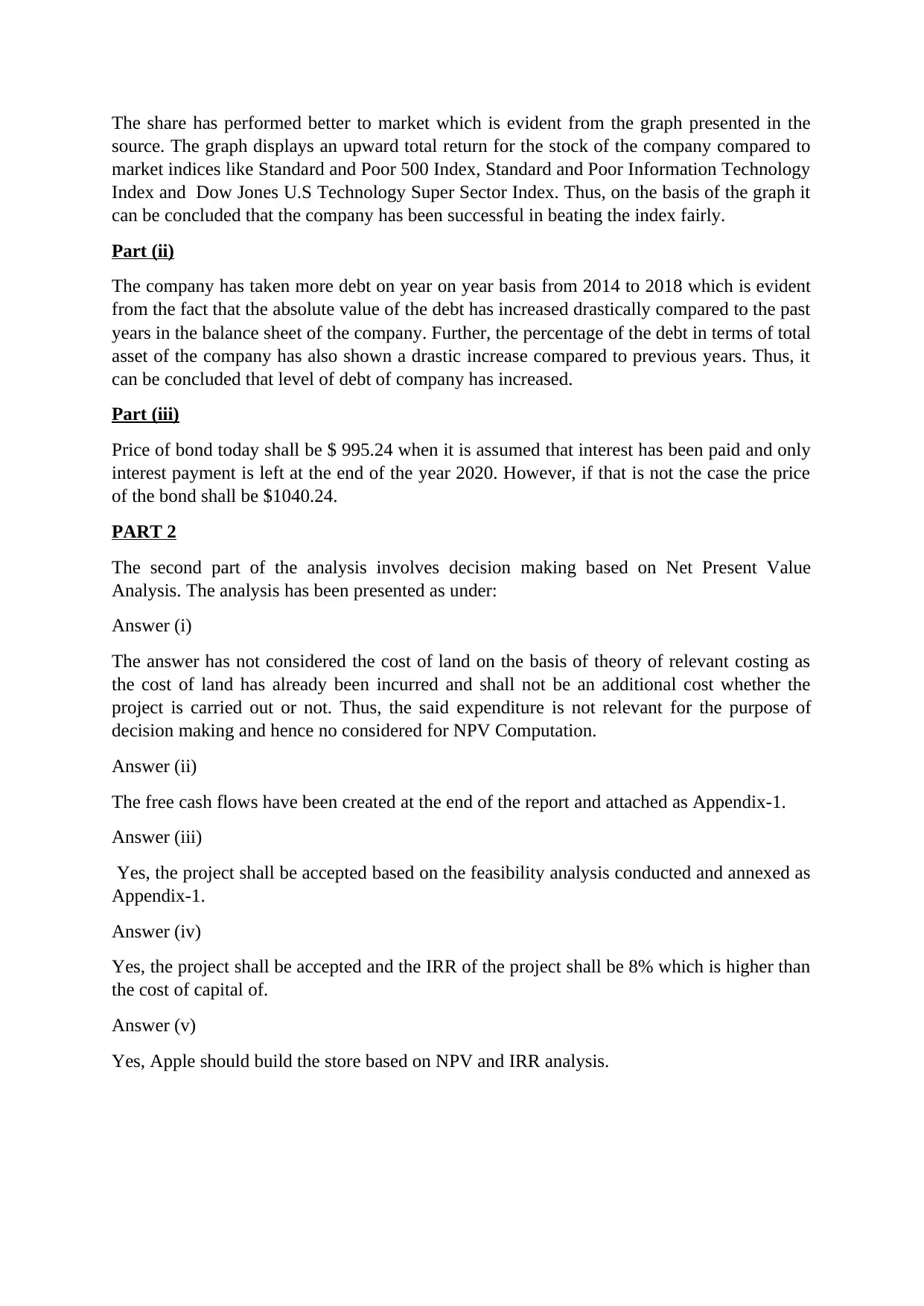
The share has performed better to market which is evident from the graph presented in the
source. The graph displays an upward total return for the stock of the company compared to
market indices like Standard and Poor 500 Index, Standard and Poor Information Technology
Index and Dow Jones U.S Technology Super Sector Index. Thus, on the basis of the graph it
can be concluded that the company has been successful in beating the index fairly.
Part (ii)
The company has taken more debt on year on year basis from 2014 to 2018 which is evident
from the fact that the absolute value of the debt has increased drastically compared to the past
years in the balance sheet of the company. Further, the percentage of the debt in terms of total
asset of the company has also shown a drastic increase compared to previous years. Thus, it
can be concluded that level of debt of company has increased.
Part (iii)
Price of bond today shall be $ 995.24 when it is assumed that interest has been paid and only
interest payment is left at the end of the year 2020. However, if that is not the case the price
of the bond shall be $1040.24.
PART 2
The second part of the analysis involves decision making based on Net Present Value
Analysis. The analysis has been presented as under:
Answer (i)
The answer has not considered the cost of land on the basis of theory of relevant costing as
the cost of land has already been incurred and shall not be an additional cost whether the
project is carried out or not. Thus, the said expenditure is not relevant for the purpose of
decision making and hence no considered for NPV Computation.
Answer (ii)
The free cash flows have been created at the end of the report and attached as Appendix-1.
Answer (iii)
Yes, the project shall be accepted based on the feasibility analysis conducted and annexed as
Appendix-1.
Answer (iv)
Yes, the project shall be accepted and the IRR of the project shall be 8% which is higher than
the cost of capital of.
Answer (v)
Yes, Apple should build the store based on NPV and IRR analysis.
source. The graph displays an upward total return for the stock of the company compared to
market indices like Standard and Poor 500 Index, Standard and Poor Information Technology
Index and Dow Jones U.S Technology Super Sector Index. Thus, on the basis of the graph it
can be concluded that the company has been successful in beating the index fairly.
Part (ii)
The company has taken more debt on year on year basis from 2014 to 2018 which is evident
from the fact that the absolute value of the debt has increased drastically compared to the past
years in the balance sheet of the company. Further, the percentage of the debt in terms of total
asset of the company has also shown a drastic increase compared to previous years. Thus, it
can be concluded that level of debt of company has increased.
Part (iii)
Price of bond today shall be $ 995.24 when it is assumed that interest has been paid and only
interest payment is left at the end of the year 2020. However, if that is not the case the price
of the bond shall be $1040.24.
PART 2
The second part of the analysis involves decision making based on Net Present Value
Analysis. The analysis has been presented as under:
Answer (i)
The answer has not considered the cost of land on the basis of theory of relevant costing as
the cost of land has already been incurred and shall not be an additional cost whether the
project is carried out or not. Thus, the said expenditure is not relevant for the purpose of
decision making and hence no considered for NPV Computation.
Answer (ii)
The free cash flows have been created at the end of the report and attached as Appendix-1.
Answer (iii)
Yes, the project shall be accepted based on the feasibility analysis conducted and annexed as
Appendix-1.
Answer (iv)
Yes, the project shall be accepted and the IRR of the project shall be 8% which is higher than
the cost of capital of.
Answer (v)
Yes, Apple should build the store based on NPV and IRR analysis.
Paraphrase This Document
Need a fresh take? Get an instant paraphrase of this document with our AI Paraphraser
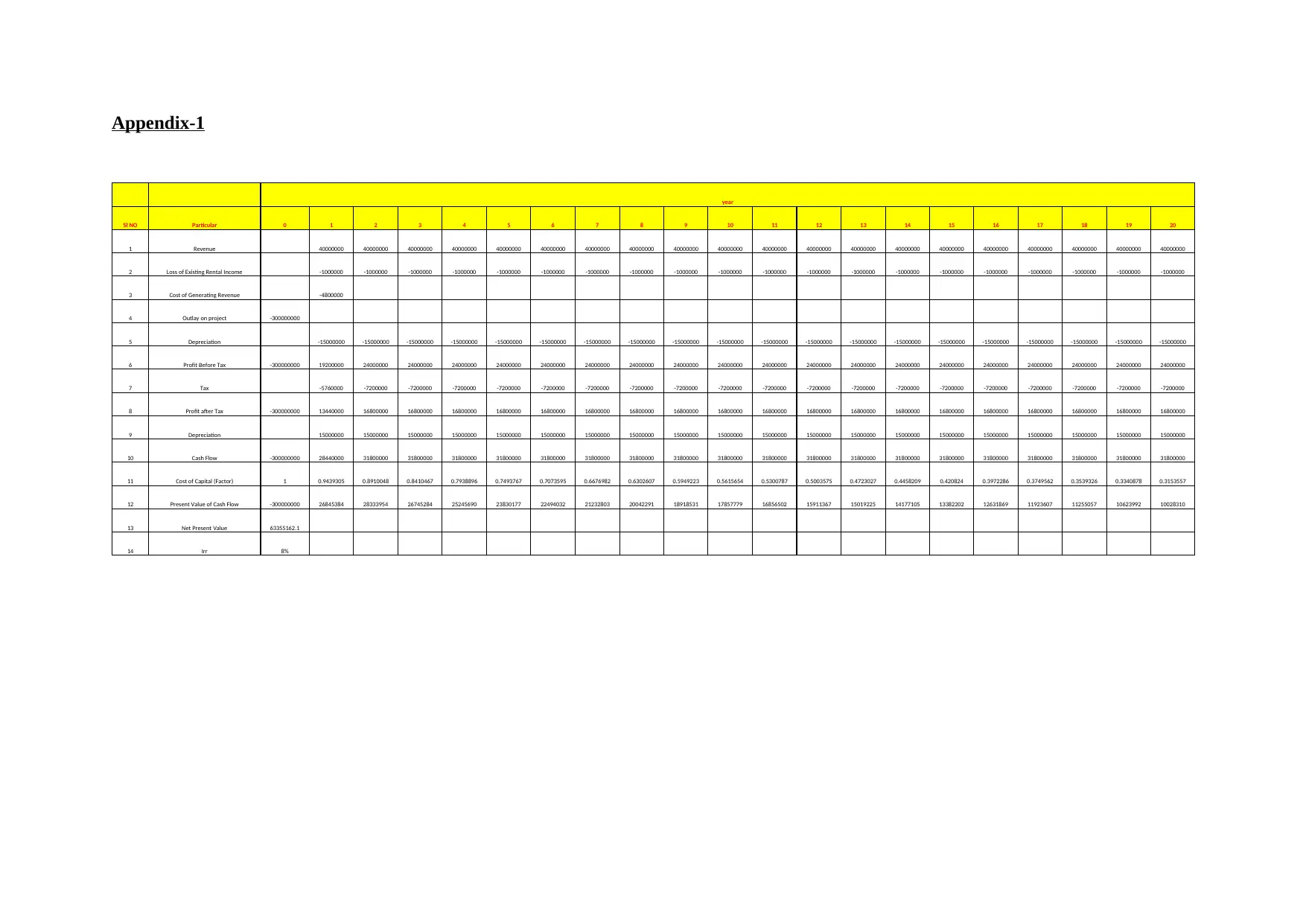
Appendix-1
year
Sl NO Particular 0 1 2 3 4 5 6 7 8 9 10 11 12 13 14 15 16 17 18 19 20
1 Revenue 40000000 40000000 40000000 40000000 40000000 40000000 40000000 40000000 40000000 40000000 40000000 40000000 40000000 40000000 40000000 40000000 40000000 40000000 40000000 40000000
2 Loss of Existing Rental Income -1000000 -1000000 -1000000 -1000000 -1000000 -1000000 -1000000 -1000000 -1000000 -1000000 -1000000 -1000000 -1000000 -1000000 -1000000 -1000000 -1000000 -1000000 -1000000 -1000000
3 Cost of Generating Revenue -4800000
4 Outlay on project -300000000
5 Depreciation -15000000 -15000000 -15000000 -15000000 -15000000 -15000000 -15000000 -15000000 -15000000 -15000000 -15000000 -15000000 -15000000 -15000000 -15000000 -15000000 -15000000 -15000000 -15000000 -15000000
6 Profit Before Tax -300000000 19200000 24000000 24000000 24000000 24000000 24000000 24000000 24000000 24000000 24000000 24000000 24000000 24000000 24000000 24000000 24000000 24000000 24000000 24000000 24000000
7 Tax -5760000 -7200000 -7200000 -7200000 -7200000 -7200000 -7200000 -7200000 -7200000 -7200000 -7200000 -7200000 -7200000 -7200000 -7200000 -7200000 -7200000 -7200000 -7200000 -7200000
8 Profit after Tax -300000000 13440000 16800000 16800000 16800000 16800000 16800000 16800000 16800000 16800000 16800000 16800000 16800000 16800000 16800000 16800000 16800000 16800000 16800000 16800000 16800000
9 Depreciation 15000000 15000000 15000000 15000000 15000000 15000000 15000000 15000000 15000000 15000000 15000000 15000000 15000000 15000000 15000000 15000000 15000000 15000000 15000000 15000000
10 Cash Flow -300000000 28440000 31800000 31800000 31800000 31800000 31800000 31800000 31800000 31800000 31800000 31800000 31800000 31800000 31800000 31800000 31800000 31800000 31800000 31800000 31800000
11 Cost of Capital (Factor) 1 0.9439305 0.8910048 0.8410467 0.7938896 0.7493767 0.7073595 0.6676982 0.6302607 0.5949223 0.5615654 0.5300787 0.5003575 0.4723027 0.4458209 0.420824 0.3972286 0.3749562 0.3539326 0.3340878 0.3153557
12 Present Value of Cash Flow -300000000 26845384 28333954 26745284 25245690 23830177 22494032 21232803 20042291 18918531 17857779 16856502 15911367 15019225 14177105 13382202 12631869 11923607 11255057 10623992 10028310
13 Net Present Value 63355162.1
14 Irr 8%
year
Sl NO Particular 0 1 2 3 4 5 6 7 8 9 10 11 12 13 14 15 16 17 18 19 20
1 Revenue 40000000 40000000 40000000 40000000 40000000 40000000 40000000 40000000 40000000 40000000 40000000 40000000 40000000 40000000 40000000 40000000 40000000 40000000 40000000 40000000
2 Loss of Existing Rental Income -1000000 -1000000 -1000000 -1000000 -1000000 -1000000 -1000000 -1000000 -1000000 -1000000 -1000000 -1000000 -1000000 -1000000 -1000000 -1000000 -1000000 -1000000 -1000000 -1000000
3 Cost of Generating Revenue -4800000
4 Outlay on project -300000000
5 Depreciation -15000000 -15000000 -15000000 -15000000 -15000000 -15000000 -15000000 -15000000 -15000000 -15000000 -15000000 -15000000 -15000000 -15000000 -15000000 -15000000 -15000000 -15000000 -15000000 -15000000
6 Profit Before Tax -300000000 19200000 24000000 24000000 24000000 24000000 24000000 24000000 24000000 24000000 24000000 24000000 24000000 24000000 24000000 24000000 24000000 24000000 24000000 24000000 24000000
7 Tax -5760000 -7200000 -7200000 -7200000 -7200000 -7200000 -7200000 -7200000 -7200000 -7200000 -7200000 -7200000 -7200000 -7200000 -7200000 -7200000 -7200000 -7200000 -7200000 -7200000
8 Profit after Tax -300000000 13440000 16800000 16800000 16800000 16800000 16800000 16800000 16800000 16800000 16800000 16800000 16800000 16800000 16800000 16800000 16800000 16800000 16800000 16800000 16800000
9 Depreciation 15000000 15000000 15000000 15000000 15000000 15000000 15000000 15000000 15000000 15000000 15000000 15000000 15000000 15000000 15000000 15000000 15000000 15000000 15000000 15000000
10 Cash Flow -300000000 28440000 31800000 31800000 31800000 31800000 31800000 31800000 31800000 31800000 31800000 31800000 31800000 31800000 31800000 31800000 31800000 31800000 31800000 31800000 31800000
11 Cost of Capital (Factor) 1 0.9439305 0.8910048 0.8410467 0.7938896 0.7493767 0.7073595 0.6676982 0.6302607 0.5949223 0.5615654 0.5300787 0.5003575 0.4723027 0.4458209 0.420824 0.3972286 0.3749562 0.3539326 0.3340878 0.3153557
12 Present Value of Cash Flow -300000000 26845384 28333954 26745284 25245690 23830177 22494032 21232803 20042291 18918531 17857779 16856502 15911367 15019225 14177105 13382202 12631869 11923607 11255057 10623992 10028310
13 Net Present Value 63355162.1
14 Irr 8%
1 out of 5
Related Documents
Your All-in-One AI-Powered Toolkit for Academic Success.
+13062052269
info@desklib.com
Available 24*7 on WhatsApp / Email
![[object Object]](/_next/static/media/star-bottom.7253800d.svg)
Unlock your academic potential
Copyright © 2020–2025 A2Z Services. All Rights Reserved. Developed and managed by ZUCOL.





